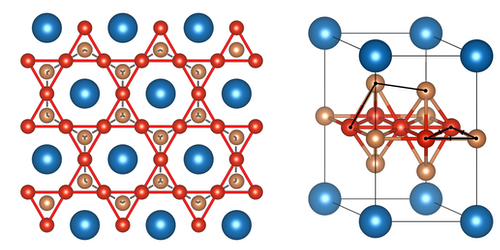A 2D Metal Compound Shows a Superconducting Surprise
For quantum computing applications, a topological superconductor is the stuff of dreams. Such a material could protect qubits from the environment, leading to an extremely long coherence time. Researchers think that a new class of materials called kagome metals might be topological superconductors, as they have topological electronic structures, and they can host superconducting correlated-electron phenomena. But researchers have struggled to simultaneously realize both properties in these metals. Now Brenden Ortiz of the University of California, Santa Barbara, and colleagues have synthesized a superconducting kagome metal that has topologically protected surface states [1]. Their material provides a platform for exploring how superconductivity emerges from electronic structures in topological materials.
Ortiz and his colleagues synthesized a cesium-rich material that forms a layered crystalline metal. The lattice structure of each layer resembles that of a Japanese basket-weaving pattern known as kagome. Taking a 2D thin film of this material, they characterized its electronic structure using spectroscopy measurements and calculations, revealing that it supports edge or surface states that act as one-way conductance channels. They also probed the metal’s magnetization, heat capacity, and electrical resistivity, showing that it starts superconducting at 2.5 K. That’s surprising, the researchers say, because until now, only 3D versions of kagome metals have demonstrated superconductivity.
The researchers note that the superconducting temperature of this cesium-rich metal does not make it a sought-after high-temperature superconductor. The superconductivity also has no obvious connection to any topological feature. Despite those limitations, they still think that the metal presents a model material for probing how superconducting electrons and surface-state electrons influence each other’s behavior.
–Rachel Berkowitz
Rachel Berkowitz is a Corresponding Editor for Physics Magazine based in Vancouver, Canada.
References
- B. Ortiz et al., “CsV3Sb5: A Z2 topological kagome metal with a superconducting ground state,” Phys. Rev. Lett. 125, 247002 (2020).




